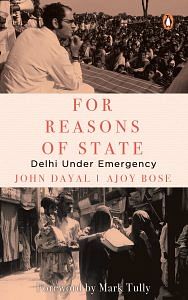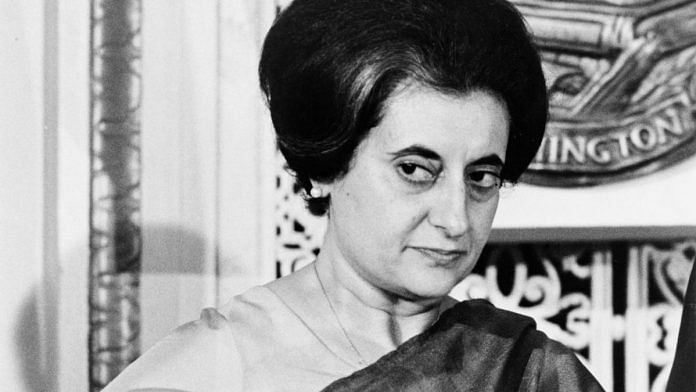Ajoy Bose and John Dayal’s book For Reasons of State: Delhi Under Emergency draws parallels between the two leaders under whose regimes the marginalised suffered the most.
There are indeed clear parallels between Indira Gandhi and Narendra Modi—two extremely powerful figures who dominate their respective eras. Both reduced their respective cabinets to no more than rubber stamps, and ran the government through supine bureaucrats. Both encouraged a band of extraconstitutional authorities. Mrs Gandhi had her son Sanjay and his cohorts in the Youth Congress, if not running the government, at least dominating it and the party. Modi maintains his superiority and has allowed the surrogacy of hate campaigns like Ghar Wapsi to sundry groups spouting extreme prejudice.
On the other hand, Mrs Gandhi’s Deb Kant Barooah as party chief did not enjoy the same place as Amit Shah occupies in Modi’s heart not just as a trusted old companion, major-domo, keeper of secrets, but also for keeping a tight rein on the party apparatus and the electoral process. Barooah, with his ‘Indira is India’ catchline, appears a farcical character compared to the far more formidable figure of Shah.
In the bureaucracy, a coterie of loyalist officers runs the country today according to the prime minister’s bidding, much as they did for Indira Gandhi. But there is no equivalent of R.K. Dhawan and the extraordinary clout he wielded during the Emergency in the current Prime Minister’s Office despite the wide-ranging powers of Modi aides Nripen Misra and Ajit Doval. The President and other constitutional offices, including even the judiciary, today have the same, if not lesser, power than they did in 1975.
There is also a striking similarity in the psyches of Indira Gandhi and Narendra Modi battling their inner demons, inadequacies and insecurities. Both consummate politicians in the rough and tumble of Indian politics, they have not cared much for constitutional niceties and liberal principles, notwithstanding the contrast between Modi’s self-proclaimed chaiwala background and Mrs Gandhi’s patrician lineage.
Indira Gandhi was never in doubt of her own superior status within her party, especially after vanquishing the syndicate of the Congress old guard. Indeed, after her stupendous victory over Pakistan, truncating it to form Bangladesh, her megalomania reached humongous proportions. She quite believed in Atal Behari Vajpayee’s supposed description of her as Durga, although he would later deny having described her in so many words.
Modi has in his prime-ministerial avatar modelled himself on Narendra Dev, Swami Vivekananda in posture if not in spirit. Twice as old as the swami, Modi still crosses his arms over his chest, wears turbans wherever he can, though he has continued to sport a beard. His public photographs, both as BJP candidate and political election leader, and as head of government, have copied the steely gaze into the distant future. The countryside is plastered with facsimiles of that face, beard and gaze, as images of Mrs Gandhi with her hooked nose and silver-framed coiffure once stared out at the landscape four decades ago.
Significantly, non-governmental organizations (NGOs) and civil society movements have been prime targets of both the Emergency regime and the current dispensation. It was Mrs Gandhi who brought in the Foreign Contribution Regulation Act (FCRA) to harass them, taking particular delight in hounding the Gandhi Peace Foundation. Modi has gone even further, using the FCRA to control the voluntary sector across the country. Many NGOs have been forced to close down or shift to programmes that depend on the crumbs his government throws at them.
Both leaders have used an elaborate propaganda campaign to project themselves as champions of the poor and downtrodden fighting the rich and corrupt. Indira Gandhi’s twenty-point economic programme and Narendra Modi’s various schemes, including his dramatic demonetization caper, share a pious zeal and moral one-upmanship designed to gain maximum public support. Ironically, the poor and marginalized have actually suffered the most under both regimes. During the Emergency, the real victims of forcible sterilizations and arbitrary demolition were Dalits and Muslims at the bottom of the social heap, most vulnerable to the depredations of the State. Indeed, the atrocities suffered, particularly across north India, by these previous vote banks of the Congress during the Emergency turned them against the party, which was a major reason why it was wiped out in the region in the 1977 Lok Sabha polls. Today Dalits and Muslims are once again the worst sufferers of a breakdown in law and order.
 Excerpted with permission from Penguin Random House
Excerpted with permission from Penguin Random House




Who wrote this crap? FYI: Nobody buys your propaganda